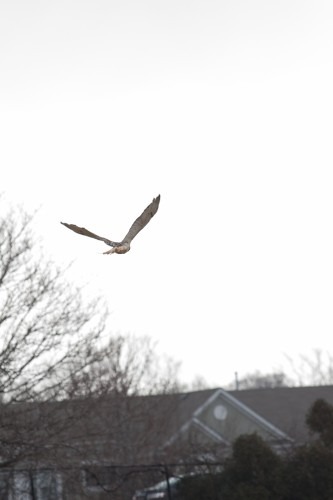We originally received a call about an injured Red-tailed Hawk sitting on a low fence on an entrance ramp to the expressway. Although we responded to the call right away, by the time we arrived there was no sign of it. We searched all around to no avail and then left.
Same thing two days later – another call about an injured Red-tail at the same location. Again, we went to the location – and again we came up empty-handed. We were frustrated and worried that this bird had been injured and without help for a couple of days.
Three more days passed and we received a call from a resident that lived near the expressway. It’s got to be the same bird, we thought. Fingers crossed that we would find him this time. We high-tailed it over there.
He was sitting on a fence facing me when I approached and at brief glance looked a bit unusual to me. I confess that when I am about to rescue a bird, I get tunnel visioned and focus strictly on making sure I get the bird swiftly and safely. I quickly assessed the condition of the bird, its apparent injuries and any surrounding hazards that might jeopardize its safety during the recovery. As soon as the bird saw me, he flushed backward off the fence into a large open park-type area between the back yard and the expressway. He could fly low but not correctly.
I went several houses south to gain access to the open field and then circled the bird wide in order to approach it from the direction of the expressway. This way if he flushed again he’d be headed back towards the houses. He was flying low but not well or correctly. He obviously had a fractured right wing.
As I approached the bird in the field, I approached low. He didn’t fly again but flipped on his back and extended his legs in defensive mode. I realized that the bird was an older male – quite striking and absolutely different than the many other Red-tails I’d rehabbed in the past. He was a bit leucistic with a lighter than normal head and creamy white up the base of his tail.

His Beautiful Chocolate-brown Eyes Contrast with His Lighter than Normal Chest and Head 
The leucism is evident in his tail 
Leucistic Red-tailed Hawk – Back View
His wing fracture wasn’t too bad but he was emaciated – no doubt from the many days of not hunting while we searched for him in vain.
Fortunately, his rehabilitation was smooth and uneventful. He pulled through the emaciation just fine and the wing healed perfectly.
We took him home and released him in time to hook back up with his mate in time for season. He’s been spotted hunting along the expressway – just like old times.

Leucistic Red-tailed Hawk Just as He Is Released

Leucistic Red-tailed Hawk Showing No Signs of Prior Injuries
For more information about Flint Creek Wildlife Rehabilitation visit us at www.flintcreekwildlife.org or www.facebook.com/flintcreek.
